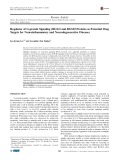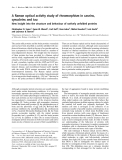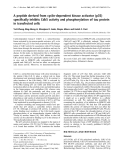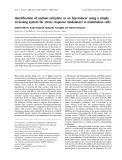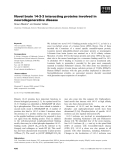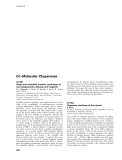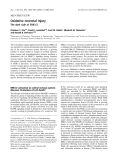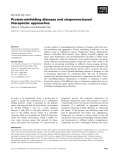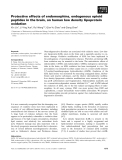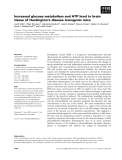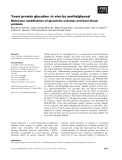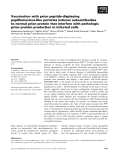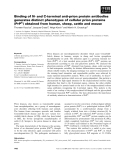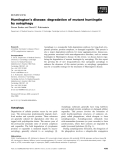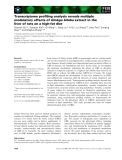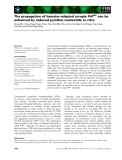
Neurodegenerative diseases
-
Regulator of G-protein signaling (RGS) proteins were originally identified as negative regulators of G-protein-coupled receptor (GPCR) signaling via their GTPase-accelerating protein (GAP) activity. All RGS proteins contain evolutionarily conserved RGS domain; however, they differ in their size and regulatory domains. RGS1 and RGS10 are smaller than other RGS proteins, and their functions involve various inflammatory responses including autoimmune responses in both the periphery and the central nervous system (CNS). Neuroinflammation is the chronic inflammatory response in the CNS.
 5p
5p  caothientrangnguyen
caothientrangnguyen
 09-05-2020
09-05-2020
 30
30
 2
2
 Download
Download
-
The casein milk proteins and the brain proteinsa-synuclein and tau have been described as natively unfolded with ran-domcoil structures,which, inthecaseofa-synucleinandtau, have a propensity to form the ®brils found in a number of neurodegenerative diseases. New insight into the structures of these proteins has been provided by a Raman optical activity study, supplemented with dierential scanning cal-orimetry, of bovineb-andj-casein, recombinant humana-, b-andc-synuclein,
 9p
9p  research12
research12
 29-04-2013
29-04-2013
 43
43
 4
4
 Download
Download
-
Cyclin-dependent kinase-5 (Cdk5) is a serine/threonine kinase activated by its neuron-specific activator, p35, or its truncated form, p25. It has been proposed that the deregu-lation of Cdk5 activity by association with p25 in human brain tissue disrupts the neuronal cytoskeleton and may be involved in neurodegenerative diseases such as Alzheimer’s disease.
 8p
8p  research12
research12
 23-04-2013
23-04-2013
 33
33
 2
2
 Download
Download
-
Asheat shockproteins (Hsps) are involved inprotecting cells and also in the pathophysiology of diseases such as inflam-mation, cancer and neurodegenerative disorders, modula-tors ofHsp expression inmammalian cells would seemto be useful for the treatment of various diseases. In this study, we isolated mammalian cell lines for screening of Hsp modu-lators; mouse C3H10T1/2 cells stably transfected with a plasmid containing the mouse Hsp105 or human Hsp70B promoter upstream of a luciferase or b-galactosidase reporter gene, respectively....
 8p
8p  tumor12
tumor12
 20-04-2013
20-04-2013
 33
33
 5
5
 Download
Download
-
We isolated two novel 14-3-3 binding proteins using 14-3-3fas bait in a yeast two-hybrid screen of a human brain cDNA library. One of these encoded the C-terminus of a neural specific armadillo-repeat protein, d-catenin (neural plakophilin-related arm-repeat protein or neurojungin). d-Catenin from brain lysates was retained on a 14-3-3 affinity column.
 9p
9p  fptmusic
fptmusic
 11-04-2013
11-04-2013
 23
23
 2
2
 Download
Download
-
Misfolded proteins, aggregates, and inclusion bodies are hall-marks of the cytopathology of neurodegenerative disorders including Huntington’s disease, Amyotropic lateral sclerosis, Parkinson’s disease, Prion diseases, and Alzheimer’s disease. The appearance of proteins with altered folded states is regula-ted by the protein folding quality control machinery and age-dependent. We have identified an unexpected molecular link between metabolic state, accumulation of damaged proteins, the heat-shock response and chaperones, and longevity....
 61p
61p  fptmusic
fptmusic
 11-04-2013
11-04-2013
 46
46
 5
5
 Download
Download
-
Protein aggregation is central to most neurodegenerative diseases, as shown by familial case studies and by animal models. A modified ‘amyloid cas-cade’ hypothesis for Alzheimer’s disease states that prefibrillar oligomers, also called amyloid-b-derived diffusible ligands or globular oligomers, are the responsible toxic agent. It has been proposed that these oligomeric spe-cies, as shown for amyloid-b, b2 -microglobulin or prion fragments, exert toxicity by forming pores in membranes, initiating a cascade of detrimental events for the cell. ...
 10p
10p  awards
awards
 06-04-2013
06-04-2013
 42
42
 3
3
 Download
Download
-
Neurodegenerative disorders, such as Huntington’s, Alzheimer’s, and Parkinson’s diseases, affect millions of people worldwide and currently there are few effective treatments and no cures for these diseases. Transgenic mice expressing human transgenes for huntingtin, amyloid precursor protein, and other genes associated with familial forms of neurodegenerative disease in humans provide remarkable tools for studying neurodegeneration because they mimic many of the pathological and behavioural features of the human conditions. ...
 15p
15p  awards
awards
 06-04-2013
06-04-2013
 39
39
 4
4
 Download
Download
-
The extracellular signal regulated protein kinases (ERK1/2) are essential for normal development and functional plasti-city of the central nervous system. However, a growing number of recent studies in models of cerebral ischemia, brain trauma and neurodegenerative diseases implicate a detrimental role for ERK1/2 signaling during oxidative neuronal injury. Neurons undergoing oxidative stress-rela-ted injuries typically display a biphasic or sustained pattern of ERK1/2 activation.
 7p
7p  dell39
dell39
 03-04-2013
03-04-2013
 41
41
 3
3
 Download
Download
-
A large number of neurodegenerative diseases in humans result from pro-tein misfolding and aggregation. Protein misfolding is believed to be the primary cause of Alzheimer’s disease, Parkinson’s disease, Huntington’s disease, Creutzfeldt–Jakob disease, cystic fibrosis, Gaucher’s disease and many other degenerative and neurodegenerative disorders.
 19p
19p  inspiron33
inspiron33
 26-03-2013
26-03-2013
 69
69
 5
5
 Download
Download
-
Neurodegenerative disorders are associated with oxidative stress. Low den-sity lipoprotein (LDL) exists in the brain and is especially sensitive to oxi-dative damage. Oxidative modification of LDL has been implicated in the pathogenesis of neurodegenerative diseases. Therefore, protecting LDL from oxidation may be essential in the brain.
 10p
10p  inspiron33
inspiron33
 26-03-2013
26-03-2013
 44
44
 4
4
 Download
Download
-
Huntington’s disease (HD) is a progressive neurodegenerative disorder characterized by multifarious dysfunctional alterations including mitochon-drial impairment. In the present study, the formation of inclusions caused by the mutation of huntingtin protein and its relationship with changes in energy metabolism and with pathological alterations were investigated both in transgenic and 3-nitropropionic acid-treated mouse models for HD.
 16p
16p  inspiron33
inspiron33
 23-03-2013
23-03-2013
 38
38
 6
6
 Download
Download
-
Protein glycation by methylglyoxal is a nonenzymatic post-translational modification whereby arginine and lysine side chains form a chemically heterogeneous group of advanced glycation end-products. Methylglyoxal-derived advanced glycation end-products are involved in pathologies such as diabetes and neurodegenerative diseases of the amyloid type.
 15p
15p  inspiron33
inspiron33
 23-03-2013
23-03-2013
 52
52
 4
4
 Download
Download
-
Prion diseases are fatal neurodegenerative disorders caused by proteina-ceous infectious pathogens termed prions (PrP Sc ). To date, there is no pro-phylaxis or therapy available for these transmissible encephalopathies. Passive immunization with monclonal antibodies recognizing the normal host-encoded prion protein (PrP C ) has been reported to abolish PrP Sc infec-tivity and to delay onset of disease.
 12p
12p  galaxyss3
galaxyss3
 21-03-2013
21-03-2013
 38
38
 3
3
 Download
Download
-
Prion diseases are neurodegenerative disorders which cause Creutzfeldt– Jakob disease in humans, scrapie in sheep and bovine spongiform encephalopathy in cattle. The infectious agent is a protease resistant iso-form (PrP Sc ) of a host encoded prion protein (PrP C ). PrP Sc proteins are characterized according to size and glycoform pattern.
 11p
11p  galaxyss3
galaxyss3
 21-03-2013
21-03-2013
 48
48
 4
4
 Download
Download
-
Autophagy is a nonspecific bulk degradation pathway for long-lived cyto-plasmic proteins, protein complexes, or damaged organelles. This process is also a major degradation pathway for many aggregate-prone, disease-cau-sing proteins associated with neurodegenerative disorders, such as mutant huntingtin in Huntington’s disease. I
 8p
8p  galaxyss3
galaxyss3
 07-03-2013
07-03-2013
 47
47
 5
5
 Download
Download
-
After the successful cloning of the first gene for a polyglutamine disease in 1991, the expanded polyglutamine tract in the nine polyglutamine disease proteins became an obvious therapeutic target. Early hypotheses were that misfolded, precipitated protein could be a universal pathogenic mechanism. However, new data are accumulating on Huntington’s disease and other polyglutamine diseases that appear to contradict the toxic aggregate hypothesis.
 11p
11p  galaxyss3
galaxyss3
 07-03-2013
07-03-2013
 56
56
 5
5
 Download
Download
-
Parkinson’s disease (PD), a common progressive neurodegenerative disor-der, is characterized by degeneration of dopamine neurons in the substantia nigra and neuronal proteinaceous aggregates called Lewy bodies (LBs). The etiology of PD is probably a combination of environmental and genetic factors.
 8p
8p  media19
media19
 06-03-2013
06-03-2013
 27
27
 2
2
 Download
Download
-
Leaf extract ofGinkgo biloba(GBE) is increasingly used as a herbal medi-cine for the treatment of neurodegenerative, cardiovascular and cerebrovas-cular diseases. Several studies have demonstrated many protective effects of GBE in neurons, the endothelium and liver.
 9p
9p  vinaphone15
vinaphone15
 27-02-2013
27-02-2013
 47
47
 2
2
 Download
Download
-
Transmissible spongiform encephalopathies (TSEs), or prion diseases, are fatal neurodegenerative disorders caused by an infectious agent termed a prion, which can convert normal cellular prion protein (PrP C ) into a patho-logically misfolded isoform (PrP Sc ). Taking advantage of protein misfolding cyclic amplification (PMCA), a series of experiments was conducted to investigate the possible influences of pyridine nucleotides on the propaga-
 10p
10p  vinaphone15
vinaphone15
 27-02-2013
27-02-2013
 42
42
 2
2
 Download
Download
CHỦ ĐỀ BẠN MUỐN TÌM








